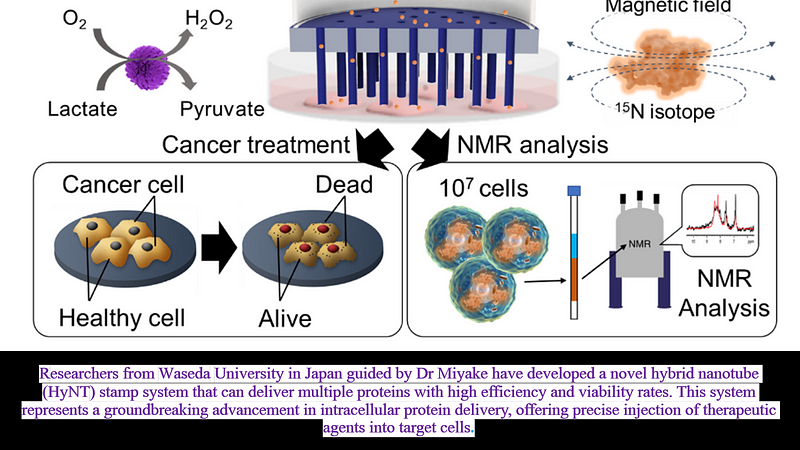Innovative Approaches in Cancer Treatment: The Role of Nanotechnology
Written on
Chapter 1: Understanding Nanotechnology
Nanotechnology presents a revolutionary approach to cancer prevention and treatment, utilizing cutting-edge methods to deliver proteins directly into cells. This technique allows for the selective targeting of cancer cells, while leaving healthy cells unharmed, thus offering a refined treatment strategy.

The author created this image using public resources from Waseda University, Japan. My keen interest lies in how nanotechnology can reshape healthcare and cancer treatment in the near future.
Cancer cells are clever adversaries, yet human creativity and innovation can overcome them. I am optimistic that ongoing advancements will lead us to victory against this challenging disease. This heartfelt narrative marks merely the start of an exciting journey.
Section 1.1: What is Nanotechnology?
Though the term 'nanotechnology' might evoke thoughts of gadgets, it is fundamentally about engineering and scientific principles at an incredibly small scale, typically between 1 and 100 nanometers. This field focuses on manipulating materials at atomic and molecular levels to create unique materials with specialized properties.
Nanotechnology encompasses various disciplines, integrating knowledge from physics, chemistry, biology, materials science, and engineering. This interdisciplinary collaboration stimulates innovation by combining diverse perspectives.
Subsection 1.1.1: The Significance of Nanotechnology
Operating on the nanoscale provides researchers with exceptional control over the arrangement of atoms and molecules, leading to the development of materials with extraordinary characteristics. Future investigations may even explore subatomic particles, potentially advancing quantum computing.
Applications of nanotechnology are vast, including:
- Medicine: Targeted drug delivery, improved imaging techniques, and regenerative therapies.
- Electronics: Development of smaller, faster, and more efficient components.
- Energy: Enhancements in solar cells, batteries, and energy storage systems.
- Materials Science: Creation of strong, lightweight materials such as carbon nanotubes and graphene.
- Environmental Science: Innovations in filtration systems, pollution reduction, and water purification technologies.
Nanotechnology has the potential to transform numerous sectors, providing innovative solutions to complex challenges and paving the way for scientific advancements.
Chapter 2: A Pioneering Study in Nanotechnology for Cancer Treatment
The first video highlights a groundbreaking cancer treatment developed at NYU, showcasing how innovative therapies can target cancer cells effectively.
A remarkable research paper titled "A Hybrid Nanotube Stamp System in Intracellular Protein Delivery for Cancer Treatment and NMR Analytical Techniques" was published by a team from Waseda University. Led by the esteemed Professor Dr. Takeo Miyake, this study presents a novel approach to intracellular protein delivery, enabling the simultaneous introduction of various substances directly into cancerous cells.

This study aims to raise awareness among aspiring scientists and foster global collaboration in science and technology.
The innovative hybrid nanotube (HyNT) stamp system delivers multiple proteins efficiently, marking a significant stride in intracellular delivery techniques.
Results have shown that the HyNT stamp system enables precise injections of therapeutic agents into target cells, representing a transformative leap in treatment methodologies.
The second video discusses lipid nanoparticles for mRNA delivery, illustrating another facet of nanotechnology's application in healthcare.
Dr. Miyake’s team successfully delivered the LOx enzyme, leading to significant cancer cell death without affecting healthy cells, demonstrating the precision of this method.
The findings from this study illustrate the HyNT stamp system's efficiency, achieving a delivery success rate of 89.9% while maintaining a high cell viability rate of 97.1%. This method's potential extends beyond cancer treatment, promising advancements in various fields, including agriculture and food production.
Conclusions and Future Directions
Nanotechnology is not a distant dream but a transformative reality in cancer treatment. By harnessing the power of nanoscale advancements, we can move toward more effective and gentler therapies.
Collaboration among scientists across disciplines is essential to maximize the potential of nanotechnology. Supporting researchers and raising awareness about its benefits are crucial steps toward a brighter future.
This innovation not only aims to treat cancer but also seeks to enhance lives and provide hope to millions. Embracing these advancements could lead us from Medicine 2.0 to Health 3.0, as envisioned by my mentor, Dr. Mehmet Yildiz.
Thank you for engaging with this exploration of nanotechnology's impact on health. I wish you a long and healthy life.
If you are passionate about health and science, consider joining my publication. Here are the submission guidelines for your reference. I also curate stories from various publications, sharing insights on diverse topics.